CFAL Client User Guide
Contents
General Notes on Windows
Application Interfaces
Data Entry – People - Notes Form
Data Entry – People - Additional Disabilities
Data Entry – People - Assistance Equipment
Data Entry – People - Consumer Goals
Data Entry – People - Employment History
Data Entry – People - Income / Benefits
Data Entry – People - Education History
Data Entry – People- Housing History
Data Entry – People - Referrals
Data Entry – People - Domestic Status
Data Entry – People - Insurance History
Data Entry – People - VR / DFB History
Data Entry – People - Attendant Info
Data Entry – People - Transport Info
Data Entry – People- Relations W/People
Data Entry – People- Relations w/Orgs
Data Entry – People - Mailing Lists
Data Entry – People - Volunteers
Data Entry - Work Log - General
Data Entry - Work Log - Group Case Note
Data Entry - Community Activities
Database Administration - Replication and
synchronization
Introduction
If I
the author were you the reader, I’d skip this introduction and head straight
for the User’s Guides, which are considerably
more useful than these paragraphs, if a bit less entertaining. This
introduction contains the usual self-congratulatory remarks about how
great our software is, along with the obligatory disclaimer that
says, in effect, that if you screw things up it isn't our fault.
The CFAL-NetCIL Database System was created by the staff of
Engineering Data Corp. (ed2c) in Louisville, Kentucky. The application is
designed to manage most of the data elements that pertain to the operation of
Independent Living Centers or other similar agencies that are charged with
basic case management operations. CFAL-NetCIL is capable of automatically
generating a variety of agency reports such as the RSA 704, HUD Section 8,
Shelter Plus Care, California CILR, and New York State
VESID, and it can interface with a variety of external data systems. CFAL
supports remote data collection so that information can be generated almost
anywhere and then transmitted to a central repository. At
present the application is in operational use by over 100 agencies
throughout the United States.
Acknowledgments
The CFAL-NetCIL system represents the culmination of
over 9000 hours of development work by a number of dedicated people.
The staff of ed2c is particularly grateful for the valuable assistance that
professionals at a number of centers have provided. Their contributions
have played a major role in making the CFAL-NetCIL database system a valuable
community asset.
This on-line documentation is designed to serve as a
basic guide to the CFAL-NetCIL Database System. In the course of its use,
you will find that you need to make a number of policy decisions regarding the
collection and interpretation of the data that you will store in your
site-specific database. As you gain insight into the system and its
role within your organization, you may develop procedures that could be of
benefit to other users. The staff of ed2c welcomes your input in order to make
this guide and the application more useful. Feel free to forward your
comments to us anytime.
Engineering Data Corp.
Box 5636
Louisville Kentucky 40255-0636
(502) 412-4000
(888) 678-0683 (toll-free in North America)
techsupport@ed2c.com
Product Disclaimer and
Licensing Statement
Most lawyers claim that Shakespeare was taken out of context when in Henry VI
he said, “The first thing we do, let’s kill all
the lawyers.” But, engineers will tell you that Shakespeare was very much
in context when in Hamlet he wrote, “For ’tis the sport to have the engineer
hoisted with his own petard.” To prevent ourselves from being hoisted (particularly
by our petards), we respectfully request that you read and acknowledge the
following statements:
• When you
purchase a CFAL-NetCIL license for your agency, ed2c grants you unlimited
rights to install the CFAL application at your site, regardless of the number
of people who use it. However, use of this software requires at least one
properly installed copy of Microsoft Access for which, as you might have
guessed, Microsoft owns the copyright. “Properly
Installed” means, in legalese, that you must have purchased at least one
licensed copy of Microsoft Access. If you have many users, then
you must also have an Access license for each of those users, or a multi-user
licensing agreement with Microsoft, or the run-time version of Access, which
ed2c can provide to you royalty-free. If you fail to follow these
guidelines, Billy Gates may send his minions in the middle of the night to
steal all of your hubcaps. Or worse yet, he may make you listen to a
Steve Ballmer speech.
• ed2c retains full rights to the CFAL-NetCIL
software and database designs. The software code and databases in
CFAL-NetCIL took us an incredibly long time to develop, and because we put so
much effort into it we decided to go to the extra trouble of copyrighting
it. ed2c owns the copyright to CFAL, meaning
that we’re the only ones who can use its source code and database designs for
commercial purposes. In order to be granted a license to use CFAL, you
must pay a license fee to ed2c. As a licensed user, you agree to use CFAL
for your own internal business purposes, and you agree that you will not
redistribute CFAL software or databases to any other organization without the
express written consent of ed2c. You also agree that any derivative
applications that you develop, if they are based on CFAL database designs, will
be used only for your own internal business purposes and not for commercial
distribution to outside parties. By agreeing to these terms, you’re helping us
all stay in business for a little while longer.
• You assume all of the risk involved in the use of this
software. If you suffer data loss, financial loss, hair loss, or any kind
of loss as the result of using this system, well blame Murphy, not us.
The good folks at ed2c will do their level best to help you with any trouble
that you might run into, but by using this software you acknowledge that Murphy
is out there, lurking, and that if you’re not careful, he’ll get you.
General Notes on Windows
Application Interfaces
CFAL
and NetCIL are Microsoft Windows-based applications; therefore all
standard features of the Windows user interface apply to the control of this
software. Windows applications provide a more sophisticated data entry
capability than do web page data entry forms, and they work well with standard
accessibility software such as JAWS and Dragon Naturally Speaking.
Most data entry, editing, and statistical analysis functions
can be accomplished through the use of input forms. Data entry fields and
buttons are designed for access by either the keyboard or the mouse. All
controls can be accessed by simultaneously pressing the "Alt" key and
the appropriate underlined "accelerator" key. In the case of
data entry fields, use of the accelerator key will also highlight the currently
displayed data for that field. If a user types any character in a
highlighted field, the highlighted information will be automatically deleted,
and replaced by the new entry. Pressing the “F2” key toggles the
highlighting of a field. Some controls may share accelerator keys; therefore
it may be necessary to type the appropriate key twice in order to activate the
function.
The “Enter” and “Tab” keys have the same effect on all input
forms. Pressing either of these keys will move the cursor to the next
input field in a form’s sequence. For hyperlink fields, the user must press the
"Tab" key to move to the next field, or the hyperlink will be
activated. Most dropdown lists are designed to "drop"
automatically when the cursor is placed in their fields. Pressing the
“F4” function key can toggle the dropdown state of a list.
For most forms with record navigators, pressing the “F5”
function key will move the cursor into the record navigator window, where a
specific record number can be typed. Pressing "Shift-F9" will
initiate a re-query of a form's data set. For more information on “Hot”
keys, please refer to the CFAL
Client Hot Key List.
Once data is typed into any record in the database, it is
automatically stored unless you press the “Esc” (escape) key. If you make
a mistake while typing data within an individual field, simply retype the
correct information while the cursor is still in that field. If you make
a more serious mistake such as editing the wrong record, press “Esc.”
Normally, you will be able to undo all of the changes that you have made to the
record.
CFAL Client input forms are designed to display full-screen
at a resolution of 1024 x 768 pixels. At lower or higher resolutions,
input forms will shrink or expand to utilize all of the viewable screen
area. Users with vision impairment who use a screen resolution of 640x480
may find that some controls are difficult to read. In such cases, we
recommend the use of the Windows screen magnifier that is integrated into the
CFAL application. Some monitors may not display correctly due
to incompatibilities with their graphics interfaces. Selecting "Do
Not Resize" on the CFAL Main form may prevent display problems from
occurring.
CFAL Client is equipped with a form for reporting problems
or recording general comments regarding its use. Selecting the “File a
Bug Report” entry from the CFAL Client Main menu reports list will activate
this form. If your installation is properly equipped, you can e-mail your
comments directly to ed2c by clicking the form's blue hyperlink.
CFAL users are divided into two main groups:
“Standard” users, and “Power” users. Normally, standard users will have
an input form such as the “People or “Phone Referral” form assigned to them by
the system administrator. If a form is assigned, it will open
automatically when the application is launched. When the form is closed,
so will the application. “Power” users have access to the Main form,
which acts as a control panel for database configuration, reporting, and output
to external data systems.
To enhance the accessibility of the application, CFAL
utilizes a number of shortcut or “hot” keys. A shortcut is a combination
of keys that when pressed together accomplish the same task as a mouse
click. For example, by pressing F1 instead of clicking “Help”, the CFAL
Client help file will appear.
Shortcut keys are identified with an underlined letter on
controls. By simultaneously pressing the ALT key plus the key that corresponds
to the underlined character, your input will have the same effect as if you
clicked the control with the mouse.
On the Main form you can use the left and right arrows, the
tab key, and the enter key to navigate from one button to another. Once the
cursor focus is set on the desired button, you can press Enter to open the form
that the button controls. Alternately, you can use shortcut keys to open the
form. Because of space limitations some keystroke combinations will open
more than one form. For example, both the Organization and Community Goal
forms can be accessed by pressing ALT + G. If the form that opens is not
the one that you want, press ALT + X to close it and then press the original
key combination again.
Data Collection Overview
Before you begin to enter data, you should make a few policy
decisions regarding the manner in which personal records will be handled.
During initial contact with an individual, every effort should be made to
collect enough information so that the individual can be uniquely
identified. Only you can decide what constitutes “enough information,”
but a good minimum criterion is a name and a phone number. For the
inevitable cases where callers wish to remain anonymous, the CFAL-NetCIL
software automatically creates an entry with a first name of “Contact” and a
last name of “Anonymous”. It’s recommended that you record a note for
each interaction with anonymous callers in this record. NetCIL IRLog
provides you with a simple facility to do so. By following this method,
proper “credit” will be given on agency reports when calculating statistics
regarding activity.
The People form represents the core of the CFAL application’s
consumer database. All information regarding consumers, collateral
contacts, intakes and referrals, and agency contacts can be entered and edited
from the People form.
Often “collateral” contacts will call on behalf of a
consumer. You must also decide how to handle such circumstances.
Ideally, a record will be written for both the collateral contact and the
consumer, and each can be classified according to contact type.
Practically, direct interactions with consumers or with collateral
contacts may be combined into a single record for the sake of expedience.
In such cases it’s best – if possible – to record the
consumer’s own name, and to reference the collateral contact in the notes field
for that consumer.
Another subject for consideration is the issue of privacy.
The CFAL database is designed with security features that will – to a point –
prevent unauthorized disclosure or alteration of consumer information. It
is NOT, however, designed to thwart malicious attack, and therefore great care
should be exercised when recording very sensitive information. It’s
recommended that extremely sensitive information NOT be recorded in the
database, but in an external document that can be physically secured.
Then, in the notes field for the individual you can simply write, “see file.”
The CFAL database contains a number of list tables that are used
to categorize consumers and your interactions with them. These lists are
designed to provide standard information for statistical reporting systems such
as the Department of Labor 704. By design, these lists cannot be modified
in the People form. This restriction helps to ensure that demographic
information is categorized in a logical way. In many cases the system
administrator can modify these lists, but care should be taken in order to
ensure that the accuracy of these reporting systems is maintained.
In any event, it’s best to form a consensus with your
colleagues about information policy before beginning data entry.
Consistency in data entry will improve the accuracy and utility of the
statistics that you will gather from your database.
When recording data, it will be helpful to consider
the following definitions:
- Definition of a “Consumer”
People in the CFAL-NetCIL database are categorized by their “Contact Type”. Contact type can be set on the People form, the Parent-to-Parent Form (if enabled), or the NetCIL IRLog application. When you first begin to interact with someone, it’s usually because they are seeking information and referral assistance; therefore when a new person is entered into the database, their contact type defaults to “Information and Referral.” When you begin to provide services to or set goals for someone, they then become a “Consumer,” and you should set their contact type accordingly. Once set, the database will never automatically change a person’s contact type. If you stop providing services to a consumer, you may wish to set the consumer’s status to “Inactive”. The criteria that you use in order to define a person’s status are entirely up to you.
2. Definition of “Transactions”
Every case note, work log entry, provision of service, or goal is considered by the CFAL-NetCIL database to be a transaction. Each transaction has an associated date, which normally will be written automatically as the current date and time when a record is entered. You can always edit the dates of any of your records. In order for statistics regarding these transactions to be included in a report, the transaction dates must fall within the reporting period as described in the following sections. For the purposes of determining activity for a given reporting period, only consumer history records with a recorded service will be evaluated by NetCIL reporting software.
CFAL Main Form
The Main form, which is the default form that is loaded on
startup, has controls that are divided into four distinct areas: Data
Entry, Reports, Database Administration, and Report Options. Buttons are
organized into two distinct groups: Black text for data entry and
reporting, and blue text for database controls.

Report Options apply to a number of database reports.
Almost all reports will return information based upon the “From” and “To” dates
that can be set in the report Options area of the Main screen. For
convenience, these dates can be set automatically by selecting an option such
as “Last Quarter.” Using these controls will cause the “From” and
“To” dates to be set to appropriate values based upon the system clock.
For more information, refer to the Reports section of this manual.
Most database administration functions have now been moved
to NetCIL Manager. For more information, refer to the NetCIL Manager User's Guide.
The Main form allows users to preset several options.
Default date ranges, screen resizing, and editing options can be set and
saved. The option check boxes are circled in read in the graphic
above. If a user selects "Save Options" and then exits the CFAL
application, the saved options will be set when the user restarts CFAL.
To minimize the chance of accidentally overwriting data,
most CFAL forms require that a user "unlock" records by pressing
the function key F3 or clicking the appropriate link. For users with a
privilege level of 8 or above, selecting "User Knows Best" on the
Main form will override this requirement, and allow record edits without the
need to unlock them.
CFAL Client input forms are designed to display full-screen
at a resolution of 800 x 600 pixels. At lower or higher resolutions,
input forms will shrink or expand to utilize all of the viewable screen
area. Users with vision impairment who use a screen resolution of 640x480
may find that some controls are difficult to read. In such cases, we
recommend the use of the Windows screen magnifier that is integrated into the
CFAL application. Some newer "Letter Box" monitors may not display correctly
due to incompatibilities with their graphics interfaces. Selecting
"Do Not Resize" on the CFAL Main form may prevent display problems
from occurring.
All data in the CFAL-NetCIL Database is stored in a
Microsoft Access file server. The location and size of the file server is
indicated in the lower right portion of the Main form, and is circled in green
in the graphic above. The file location is a hyperlink; clicking on this
link will open a window to the directory where the file server is located.
Data Entry - The People Form
The People form is divided into three sections.
The top section is used to perform record searches, the middle section
contains basic demographic information, and the bottom rows of buttons allow
access to transaction data and reports.

Before
entering a new record, it's good practice to perform a search in order to
minimize the chance of duplicate entry. There are several ways to search for
records in the People form:
When
function key F5 is pressed, a pop-up search form will appear:

When searching by
name, a dropdown list that contains all records in the database will be
displayed, along with their contact type and telephone number. Only
the selected record will be returned.
When searching by
keyword or query, all records that match the search request will be returned.
For example, if you have associated 35 consumers with a keyword phrase
called Friday Night Book Club,
selecting this keyword will return all 35 records in the People form.
At the bottom left
corner of the People form there is a record navigator. If many records
are returned as the result of a search, you can scroll through the records by
clicking on the right arrow located next to the record number until the desired
record is displayed.
![]()
Other search methods in
the people form allow you to search by Last
Name, Social Security
Number, Home Phone Number,
or Work Phone Number.
Several function keys are available to "jump" the cursor to the
desired search field, or to unlock the currently-displayed record for editing:
F9: To search by Last Name
F10: To search by Social Security Number
F11: To search by Home Phone number
F12: To search by Work Phone
Note that function key
F3 is used to unlock existing records for editing. Clicking in the search
fields, or the F3 Edit and F5
Search labels, has the same
effect as pressing the corresponding function key.
Last Name searches can utilize the wild card character *, and are not
case-sensitive. For example, a search for sm*th will return all records with last
names Smith and Smythe.
You can enter as many wild card characters in the search string as you wish. Sm*th* will
return all Smiths, Smythes, and Smithsons.
Note that the use of wild cards may result in slower search results. All other
searches will only return records that match the search criteria exactly.
The results of the most recent search will be displayed in red in the
right-most portion of the search section.
Selecting the Show All check box in the upper right corner of
the People form will display all records in the database. You can then
use the record navigator to find the desired record, or you can use the
built-in search and filter capabilities of Microsoft Access.
Datasheet View
Once you have checked
the Show All checkbox, you may want to view your
data as a spreadsheet instead of the standard CFAL form view. To do so, double
click on the first name of a person. You can go back and forth from one view
into another by double clicking on the first name of person. If you cannot use
a mouse, you can select View, Datasheet View (for MS Access 2000 to 2003). Or if
you are using MS Access 2007, maximize the ribbon first,
then select View, Datasheet view. Please
note that the user will have the same privilege level on either view.
Importing a Contact
from Outlook into the People Form
If have a
contact in your Outlook address book that you would like to import
into the People Form of CFAL, you must first save your
Contact as a V-Card in Outlook by pressing Save As and Exporting
the Contact as a V-Card form (.vcf
format). Remember the location where the V-Card is saved. Then, open
the People form and select New. Click on the Import
/Export Contact icon (see
below) or press [F2] on your keyboard. A window will open
and will ask you to locate the V-Card file. Navigate to where the V-Card is
saved and select Open. You
will then get a message saying that the V-Card was successfully imported
and after you click ok, your contact will appear
on the People Form of CFAL.
![]() Import/Export Contact Icon
Import/Export Contact Icon
Exporting a Contact from
the People Form to Outlook
If you have
already entered a contact on the People form of CFAL and would like
to Export it into your Outlook address book, you can do so by first pulling the
record up on the screen then clicking on the Import/Export
Contact icon or by pressing
the [F2] key on your keyboard. A window will open and ask if you would like to open this file? Click Ok to proceed. Your
Outlook address book will open with the new contact. Select Save and Close to keep this contact.
Sub-Forms
Below is the list of all
sub-forms. When selected, the bottom row of buttons will open pop-up forms that
allow entry of a variety of transactions that are related to the displayed
record. Pressing More
Options will change the
button labels and their functions as indicated in the graphic above.
Each of these functions is discussed in the Data Entry sections of this
manual.
![]()
![]()
![]()

The Letter
button allows you to add a person into the queue to receive
a letter. When you click on the button, a dropdown list of
pre-configured letters will appear. Select the appropriate letter from the
list and Exit the form. This process will have added this person
automatically into your letter queue when you perform your
next Mailing.
The Report button
will generate a detailed report which will display information
previously entered in all sub-forms of the People form.
The Resume button helps generate a
resume for an individual by transferring some information previously
entered on the People form (Name, Address,
Telephone Number and Email) and in the Employment form
(Employer and date).
The Notes Report generates a
report of all notes previously entered.
The Delete button will only
be available to level 10 users or Database Administrators.
The New button allows you to enter a
New record.
The Exit button closes the People form.
Data Entry – People - Notes Form
General Information
on Notes
The Notes &
History sub-form provides a method to record general interactions with
an individual. As new records are written, the date and time of entry and
the user’s ID are automatically recorded so that a transactional history can be
compiled. An Initial Entry record is automatically generated
when an individual’s data is first recorded. Do not delete this record,
as it is used for reporting purposes. To enter a new note, press the New button and select a category for the entry
from the drop-down list in the Category field. Select a category that
relates to the information that you need to enter. Please note that the default
category is General Case Note. The Date field can
be edited as necessary. Hours spent on the
interaction can be recorded in fifteen-minute intervals. If services
were provided and/or your work was performed as part of a grant, specify Grant
Type and Services as applicable. Contact Type is
an optional field that can be used to further categorize your
notes. For official state and federal reports such as New
York VESID, California CILR or the federal RSA 704 reports, please note
that only a note for which a service was selected will count
as "served" during the period.

To edit an existing
record, the user may have to first click on the F-3 key if
the User Knows Best check on the Main form is
not checked. There will be cases where the database user will only be
allowed to edit his or her own records. This is
determined be their user level. A database user set to a level 8 or
above will be able to edit all notes. A user set below a level 8, will only be
able to edit their own notes. Only the database administrator, the level
10 user will be able to delete any notes.
You will also note
that the selection of certain categories causes additional edit fields to
appear. For example, on the People form, when the Contact
Type is changed from Consumer to Inactive
Consumer, the notes will open automatically to the category Consumer
Becomes Inactive, and an additional field appears next to
the Grant Type drop-down box where you can record the reason
why the individual became inactive. The following graphic illustrates
such a case:

Appointment /
Reminder Feature
It is also possible
to set a reminder or an appointment from CFAL to your Outlook Calendar.
To do so, press the New button and
select Appointment / Reminder from the Category drop-down
list. Set the Date of your appointment/reminder and
use the Hours drop-down list to set the approximate duration of the
appointment. Write a brief description of your appointment/reminder in
the Notes field as illustrated below:

On the appointment
date, a reminder message will automatically
appear when you log on to CFAL. This reminder message will only appear on
the date set. Just select Yes
to View your appointments.


Copy Appointment to
Outlook
To copy the
appointment/reminder to your Outlook Calendar, click on the Reminder Icon ![]() located just below
the Notes field or press F2 on your keyboard. This will open Outlook
Calendar. Just Save and Exit to keep the
appointment/reminder. If you set a time in the Date field
and a duration in the Hour field, Outlook
will transfer the reminder at the exact time that you have set. If you do
not want to save this appointment/reminder in your Outlook Calendar or if
you do not use Outlook, just skip this step.
located just below
the Notes field or press F2 on your keyboard. This will open Outlook
Calendar. Just Save and Exit to keep the
appointment/reminder. If you set a time in the Date field
and a duration in the Hour field, Outlook
will transfer the reminder at the exact time that you have set. If you do
not want to save this appointment/reminder in your Outlook Calendar or if
you do not use Outlook, just skip this step.
Multiple Services
Often during
interaction with a consumer, more than one service will be provided or work
will be performed under more than one grant. The most accurate way to
record such activity is to write multiple case notes – there is no limit to the
number of notes that can be recorded. By writing multiple notes, the
amount of effort expended for the provision of each service will be accurately
recorded. All reporting in the CFAL system is based upon the
number of hours recorded by service or grant.
The notes field is
a free-form area where you can record any comments regarding your interaction
with an individual.
At your option, you
can also specify the core services that are provided during each interaction.
Any or all of the core services check boxes can be selected. Note
that these boxes are provided for your internal reference only, and are not
used for reporting.
Apply Services /
Notes to Goals
The Notes form
also allows you to assign provision of a service to any goal that has been
previously recorded for a given Consumer. An Apply to Goal dropdown
list is displayed showing all goals, even if they have been closed. The
dropdown list displays the Goal Description and Goal Start Date. A Sample
Services Applied to Goals query will display goals, services, hours,
and dates for all records.

Datasheet View for
Notes
Notes can be
viewed as forms or datasheets (spreadsheet). To switch modes,
select View…Datasheet View or View…Form View when
the Note form is open. The view can be toggled by
double-clicking the Date field. Please note
that new records can only be added in the form view. Existing
records can be edited in either view, as long as a user has sufficient
privilege.

Preview Notes
As shown on the
graphic below, there is an option to Preview all Notes or
just a specific note for the consumer. At the bottom of the Notes screen, the From and To fields will allow
you to enter a date range for your report. The notes that will appear
on the report will only be the ones included in the specified
period. If no dates are entered, the report will include the entire note
history record. If the Preview this Note button is selected,
the report will only include the note shown on your screen.

Data Entry – People - Additional Disabilities
An
individual’s primary disability can be recorded on the People form. If
additional disabilities need to be recorded, you can do so via the Additional Disabilities form. Select the disability from the
drop-down box, assign it a rank, and enter the date and any notes as
applicable. The disability listed on the People form should be #1 on
the Rank column.

Data Entry – People - Assistance Equipment
The Assistance Equipment sub-form is used to enter data on equipment
that is loaned by you to an individual, or to enter information about any
assistance equipment that they may already possess. Select the equipment type
from the Assistance Equipment drop-down
box, indicate if the equipment is a loan, and in such cases enter a loan date and a return date.
When the equipment is returned, enter the Returned Date. The Borrower Form button will display a Borrower’s Agreement form for the consumer to sign. The View Inventory button allows you to enter, edit, and
manage your inventory. By checking the Equipment Loan box, the item will automatically be removed
from your inventory until it is returned.

Data Entry – People - Consumer Goals
Consumer Goals and
ILP
This form allows the
user to define the ILP (Independent Living Plan) and set goals for
their consumers. Once you have selected ILP developed on the People form, click on Goals
and ILP and press the New button to set a new
goal. This will drop down the list of preset Goal Standards. Make
your selection from the list (if you have some preset goals), if not, select an
option from the Significant Life Area drop down
list. This list is set by RSA and cannot be
modified. If the goal will improve the consumer's access to either Assistive Technology, Health
Care or Transportation, make your selection from
the Access Category drop down list. If not applicable, this
field can be left blank. Set the Goal Start
Date, a Goal Target Date and an Actual
End Date when the goal is completed. You may set as
many goals as you wish to for anyone in your database and add any notes that
pertain to the Consumer Activity, Consumer Progress, Staff
Activity and the final Outcome of the goal, as shown
below. Only the Significant Life Area, Access Category,
Start Dates and Actual End Dates fields are
currently used for federal and state reporting purposes.

The Goal form also
allows you to better define the Independent Living Plan. By clicking
on the ILP Checklist button, a new screen will open
with a list of options that are normally required when developing an
Independent Living Plan for a consumer. You may select any or all of the
items. When you do so, CFAL automatically writes a case note to record
each element of the checklist. Once completed, you can preview or print
an IL Plan report that can be signed and placed in an individual consumer’s
paper file.
Datasheet View for
Consumer Goals
Goals can be
viewed as forms or datasheets (spreadsheet). To switch
modes, select “View…Datasheet View” or “View…Form View” when the Goal
form is open. The view can be toggled by double-clicking the
"Goal Start Date" field. Please note that new records can
only be added in the form view. Existing records can be edited in either
view, as long as a user has sufficient privilege.

Data Entry – People - Grant History
The Grant History sub-form
is used to intake a consumer into a grant or program. By pressing the New button you can select a Grant or a Program
from the drop-down list. Set the Intake date and a comment if
you wish. Certain grants or programs have an associated Requirements
Form, where you can record any required additional information. When
you press the Req. Form button the associated Requirements
Form will appear, or you will see a message that says, No form has been
defined for this grant. Complete the form as applicable
and press Exit to return to the Grant History sub-form.
The Grant History sub-form allows centers to gather statistics
and run reports based on specific grants or programs.

Data Entry – People - Employment History
Use Employment
History to enter data about a consumer’s past or present employment.
Enter applicable data as desired. The number of days worked is
automatically calculated based on the dates that you enter. If the
employment is current, leave the end date blank, and the number of days worked
will be calculated based on the system clock.

Data Entry – People - Income / Benefits
The Income/Benefits History sub-form is used to enter data about a
consumer’s income and benefits history. Select the type of Income/Benefits from the drop-down list, and then enter the Amount, Start Date, End Date, and Notes as applicable. This form allows you
to select multiple sources of Income
and Benefits. Reports that calculate income will use this information
rather than data from the employment section.

Data Entry – People - Education History
The Education History button is used to record the education
experience of a consumer. Select the applicable Education type from the drop-down box, the date, and
any appropriate comments.

Data Entry – People- Housing History
Use Housing
History to enter present or past housing data for a consumer or to specify a Housing
Type from the drop-down box. Enter the Date, Address,
City, State, and Zip as appropriate. When an
address is entered on the People Form, it is automatically
transferred onto the Housing History sub-form. Every time a
change occurs on the People form, the old record will be kept
in the Housing History but the new address will remain first
as to show current address.

Data Entry – People - Referrals
The Referrals sub-form is directly linked to the NetCIL I&R Log application All
data recorded from I&R
Log will appear in the Referral sub-form. The Referrals button is used to specify any
referrals that you make for an individual. Select the Service and enter the Hours, Request Date, Completion Date, Grant, Referred from Organization, Referred to
Staff, and Referred to Organization as appropriate.

If
you refer the person to a Staff and leave the Completion Date blank, the staff who received the
referral will be alerted next time they open CFAL. The message will
indicate that they have Open
Referrals and
whether they want to View them or not. As long as the Completion Date is left blank, the Open Referrals message
will continue appearing every time they logon to CFAL and the
referral will be counted as a Service Requested but not Received in
the Service section of the RSA/704 and various state reports.

Data Entry – People- Keywords
Keywords provide another way to make associations in your
database. The CFAL database administrator can create a set of keywords in
order to classify groups; the sub-form allows you to associate any keyword with
any person in your database. Press the Keywords button at the
bottom of your screen, then the New button
to add a keyword association. You can repeat this process as many times as you
wish. When done, press Exit to return to the People form.
By associating people with keywords, you will enhance your search capabilities.

Once the keyword
link has been established, you can retrieve records linked to
a specific keyword by selecting F-5 and
selecting By Keywords: as illustrated below.

Data Entry – People - Domestic Status
Use
the Domestic Status sub-form to enter an individual’s marital
status. Select the applicable Marital Status from the drop-down box, the number of Persons in Household, the Date, and
any comments as applicable.

Data Entry – People - Insurance History
The Insurance History sub-form is used to enter data on the
insurance status of an individual. Enter data as appropriate. To add additional
information click the New button at the bottom right of the screen.

Data Entry – People - VR / DFB History
The VR/DFB Status sub-form is used to record
Vocational-Rehabilitation data about an individual. Enter data as appropriate.
If the consumer is not a client of DR/DFB this form
can be left blank.

Data Entry – People - Attendant Info
The Attendant
Info sub-form is used to record information about an individual’s
attendants or attendant needs. Enter data as appropriate. If the consumer
does not have an attendant this form can be left blank.

Data Entry – People - Transport Info
The Transport
Info sub-form is used to record information about an individual’s
transportation needs or capabilities. Enter data as appropriate.
Note that multiple transportation records can be written, so that changes in a
consumer’s transportation capabilities can be recorded. To add additional
transportation information click the New button
at the bottom right of the screen.
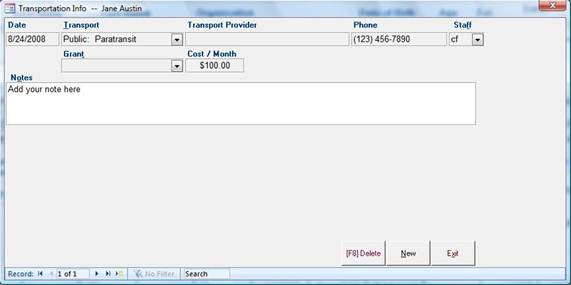
Data Entry – People- Relations W/People
The CFAL database
has the ability to associate many of its data elements with other elements in
the database. The Relationship sub-form allows you
select any person in your database (from the drop-down list) and associate them
with the individual whose record you are editing. You can also specify
their relationship in the Relationship field. This is
useful if two of the consumers are related in some way such as husbands and
wives or roommates.
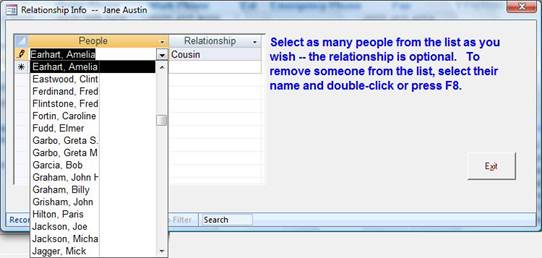
Data Entry – People- Relations w/Orgs
The Relationship
with Organization sub-form allows you to associate a person with an
organization. Every organization that has previously been entered in
the Organizations form will automatically appear in the
drop-down list. You can associate a person with as many organizations as
you wish.
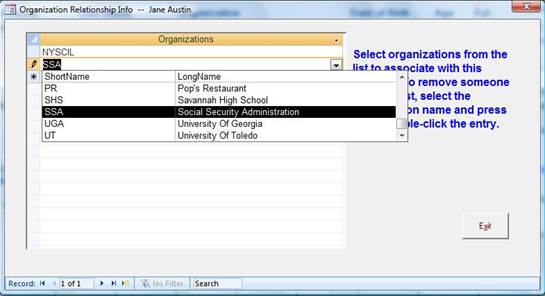
Data Entry – People - Mailing Lists
The CFAL database
administrator has the ability to create mailing lists. This sub-form
allows you to associate a person with those predefined mailing lists. You
can associate a person with as many mailing lists as you wish. Mailing
lists provide an easy way to manage correspondence. This feature allows you
to list which documentation or newsletters each consumer is
receiving.

Data Entry – People - Volunteers
This
sub-form is used to identify people in your database who are willing to work as
volunteers. The form is designed to categorize volunteers by the types of
activities that they are willing to perform as well as the times that they are
available. If your organization does not have a volunteer program this form can
be left blank.
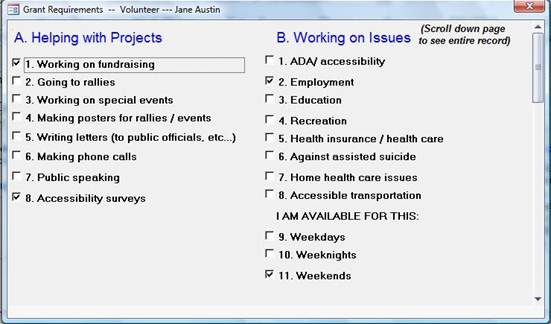
Data Entry – People - BFS
The Blind Field Service Report can be accessed through Netcil
Manager in the report dropdown menu. This report lists the number of consumers
with visual impairments that your agency serves during a given time period.
These consumers are categorized by: age, gender, race/ethnicity, type of vision
impairment, cause of vision impairment, duration of vision impairment, onset of
impairment, education level, living arrangement, as well as non
vision related impairments. Please note that this grant requires
a specific configuration of your file server. Please contact
Engineering Data if you need additional configuration for the Blind Field Service grant
(or Chapter II grant).
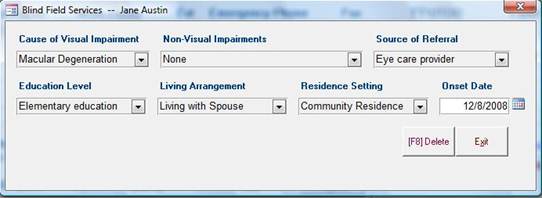
Data Entry - Work Log - General
The Work
Log is used to record staff activity related to Community
Services or Activities, trainings, seminars and Group Case notes.
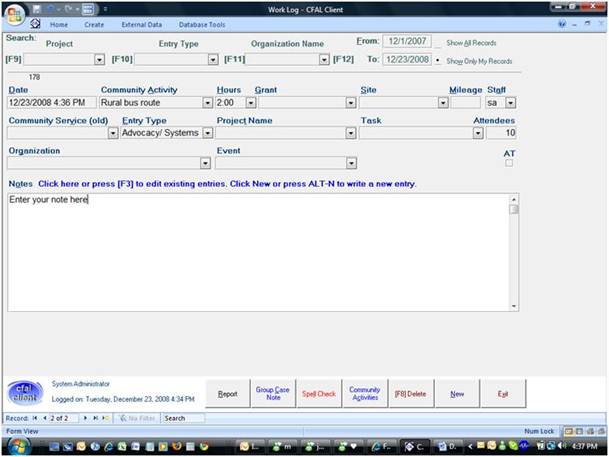
To
record staff hours, press the New button
to add a new record. Then enter the date of your Work Log activity.
If your Work Log entry is related to a Community Activity that
has already been configured through NetCIL Manager, choose that
activity from the drop-down list.
Record the number of hours you spent on the activity from the Hours drop-down
list (you may want to include your travel time or administrative time in your
entry). If the activity is associated with a specific
grant, choose that Grant from the drop-down list.
If the activity has taken place outside your agency you can list the location
in the Site drop down list along with the mileage from your
agency to that location.
CFAL users from California must choose an activity type from the Community
Service Old drop-down menu for the Work Log Entry to be counted on the
State CILR report. For more information on the California State Report,
please refer to the CILR Data collection protocol.
Enter an Entry Type from the drop-down list to record a
more detailed entry that best describes the type of Work Log
activity.
If the Work Log activity is associated with a project or task that has already
been configured through the Project Form of CFAL, select
it from the Project or Task drop-down menus. See the Projects section
of the manual for more details.
If the activity involved the public or more than one consumer enter the number
of Attendees in the that
box.
You can also associate to Work Log entry with an Organization or Event that
has already been entered in the CFAL Organizations and Events forms .
For California only: If the Work Log entry is related to your AT services
choose from the AT Targeted Outreach drop-down menu and make
sure the AT box is checked.
Then enter a brief description of the activity in the Notes field.
These descriptions do not have to be lengthy because they will not show up on
any of your reports, they are just for your internal
reference.
If you are unable to enter all your Work Log activities on the day that they
occur you can change the date on each new Work Log entry to reflect the actual
date that the activity occurred. These entries will then be listed in
chronological order within your Work Log.
Data Entry - Work Log - Group Case Note
If
your Work Log entry involved more than one consumer and you would like to post
the Work Log entry directly to the consumers file, you can use the Group
Case Note feature
from the Work Log.
Start
by entering the necessary information that best describes your entry.
Enter the date of the activity, the number of hours you spent with
the consumers. Choose a Grant from the drop-down menu if the activity is
associated with a specific grant. Once you have finished your entry,
press the Group
Case Note button
at the bottom of the screen.

A new
window will open and your note will be automatically transferred. Select a Contact Type and a Service to
associate with the activity. If you have already associated some
people with a specific Keyword on the People / Keyword sub-form , enter that keyword and those consumers will
automatically be listed. Or you can choose every
person separately by selecting them on the People drop-down list. Once a person is
selected, use the Enter key on your keyboard to move to the next
line. Repeat the process for every person that you want to select.
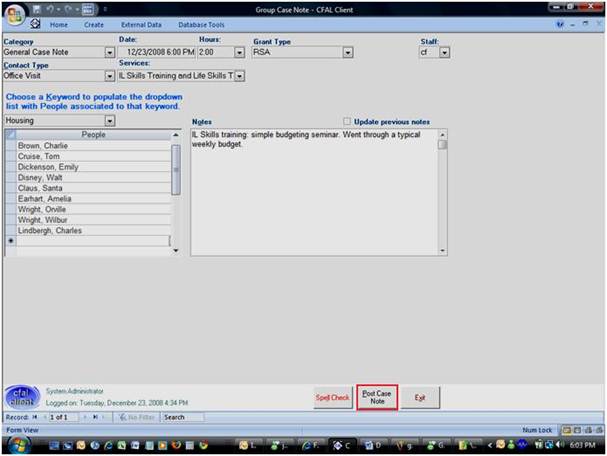
After
finishing the case note click the Post Case Note button at the bottom of the
screen. A confirmation message will appear. Select OK to close the confirmation message.
Every person selected will now have the note in their records.
Just select Exit to return to the Work Log window.
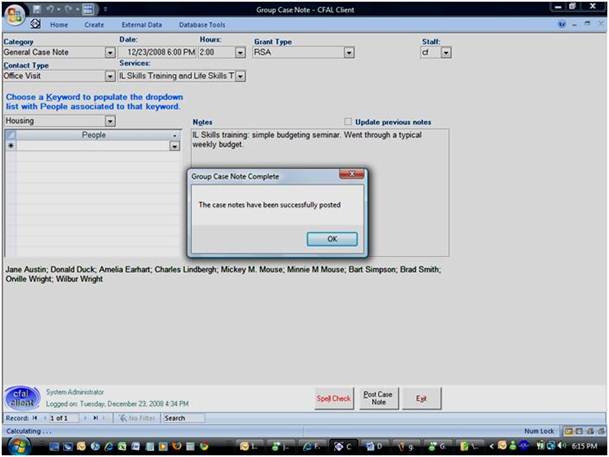
Data Entry – Organizations
The
CFAL database can store information about any of the Organizations with which you normally interact. As with most CFAL forms,
a facility is provided to search for organizations in your database.
To conduct a search, select one of the following methods:
F3: Unlock
current record for editing
F5:
To display a list showing all organizations in your database
F9: To search by
Organization
F10: To search by City
F11: To search by a Keyword
associated with an organization.
If a
keyword is associated with more than one organization, all of the organizations
associated with that keyword will be returned. The number of
organizations will appear in the Record field at the bottom left corner of the
form. By clicking on the right arrow located next to the record number,
you can navigate through the list of organizations that were returned by the
search.
F12: To search by phone
number
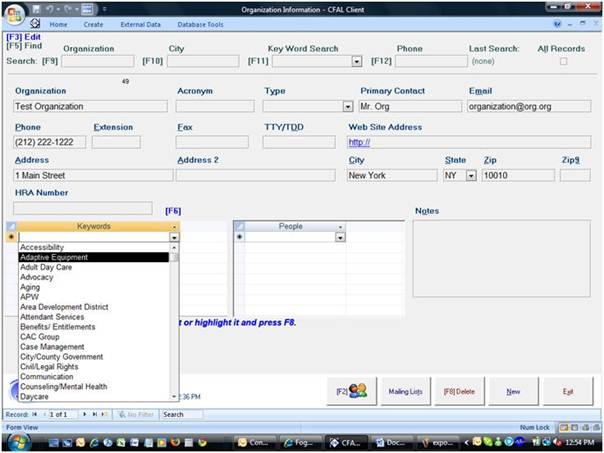
To
add a new organization to the database, press the New button in the bottom right hand corner of
the screen. Enter all desired information such as Organization, Acronym, Type, Primary Contact, e-mail, and Phone. You may also associate
keywords with the organization in order to enhance your search
capabilities. An organization can be associated with as many Keywords as you wish. You can also enter notes to briefly
describe each organization in the Notes field. Once the organization has been entered into
CFAL, you can Export it to your Outlook address book
as a V-Card by pressing the icon or by pressing the F2 key on
your keyboard.
 (Export to Outlook Icon)
(Export to Outlook Icon)
A security
warning window will open and ask you if you want to Open
this file. Press Ok to view the V-Card.
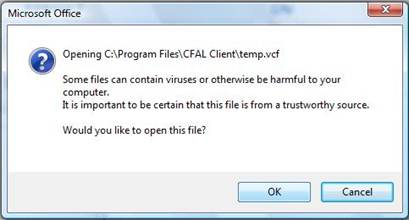
Once the V-Card is open, you will need to press Save and
Close to keep this organization in your address book.
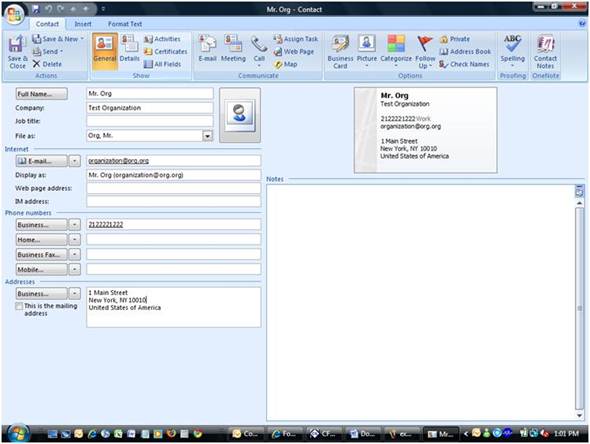
Please
note that if you do not use Microsoft Outlook, the Export feature will not
work.
It is advisable that one or two people within your agency be
given the responsibility of maintaining the organization list to ensure that
there are no duplicate organizations listed within the database. If
everyone in your agency enters organizations it is likely that several
organizations will be repeated within the list and it will become difficult to
accurately document your activities with each organization.
Data Entry - Community Activities
Independent
Living Centers who need to submit a federal RSA/704 Report have to record
hours spent working towards their Community Activities goals. Community Activities must be entered into the CFAL database via
the Community Activities button or through the NetCIL Manager Config menu by an agency
administrator.
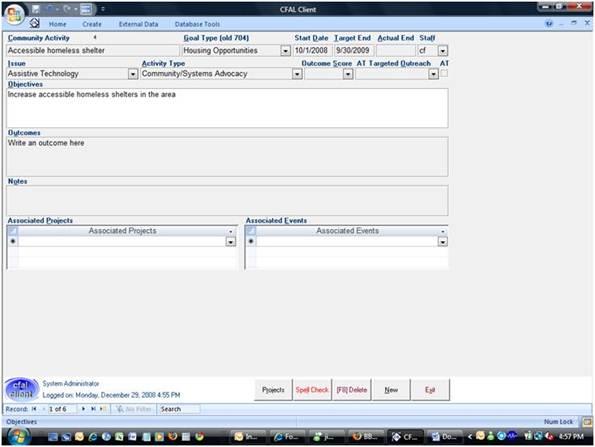
Community
Activities are long range or overarching goals related to community
wide issues that the ILC wants to achieve as a whole. These
Community Activities should be created by the Executive Director or other
management staff from the agency's yearly plan. Therefore, there should only be a few Community Activities created each
year. The Community Activities screen should not be used as a Work Log to
Record meetings or outreach activities.
To
add a new Community Activity click the Community Activity button on the front screen of the CFAL
database. Then
click the New button in the
lower right-hand corner of the screen. Create a title for the Community
Activity that briefly describes the activity. This title will appear in
the Community Activity drop-down
list in the Work
Log Form and
will be used by staff to record their hours. For California Centers,
select a Goal Type (704 old) from the drop-down list to be associated
with that specific Community Activity.
Record
a Start Date for the Community Activity along with a Target End Date.
Once the Community Activity has been completed, enter an Actual End Date for that activity. When the Actual End Date has been entered, that Community Activity
will be listed on the 704 report as completed and once the date
has passed, that Activity will no longer appear as a choice Community
Activity drop-down
list in the Work
Log Form.
Select an issue from the Issues drop down
list to associate that specific Community Activity with an issue tracked by the
704 report. If the issue you are working on does not appear in the
drop-down list, a database administrator can add another issue to the database
table called Community Issue Codes. Choose an Activity
Type that relates to the specific Community Activity you are
creating. This information (Community Issue and Activity
Type) will also be recorded on your annual 704 report.
When a Community Activity has been completed enter an Outcome Score into the drop down
list.
For California Centers: If a specific Community Activity is
related to AT services select from the AT Targeted Outreach drop down
list and make sure the AT box is checked so that activity will be recorded
within the AT section of the 704 report.
Enter a brief description of the Objectives
and Outcomes for each Community Activity. These fields
will automatically be transferred onto the Community Activity
section of the federal RSA/704 Report.
Projects and Events previously configured can also be associated with each Community
Activity that will appear in the corresponding drop down lists.
Once a Community Activity has been added to the CFAL
database it will appear in the drop-down menu on the Community
Activities screen. Each time a staff person spends time working on a
specific Community Activity those hours should be recorded in that staff
person's work log. These hours will be calculated and recorded in the
appropriate sections of the 704 report.
Each
Community Activity must have a name in order to appear in the Work Log
drop down list. Staff members must choose a Community Activity and
select the number of hours they spent working on that activity within
their Work Log. The number of hours spent by staff on each Community Activity
will then appear on the 704 Report.
Data Entry – Projects
You can search
for Projects in much the same way that you search for people. To
do so, utilize one of the following methods:
F9: To search by Project Name – list of projects will be displayed
in the dropdown box.
F10: To search by Keywords that are associated with a project. If a keyword is
associated with more than one project, all of the projects associated with that
keyword will be returned by the search. You can view the number of
projects returned from a search by examining the Record field
at the bottom left corner of the form. By clicking on the right arrow
located next to the record number, you can select the project that you wish to
open.
F11: To search for projects starting on a
certain date.
F12: To search for projects ending on a
certain date.
To add a new project, press New and then enter a Project
Name, Project Description, Start Date and End
Date if applicable. By clicking on Goals or Keywords a
drop-down list will appear from which you can select associations as you see
fit. The following graphic illustrates
the Projects form:
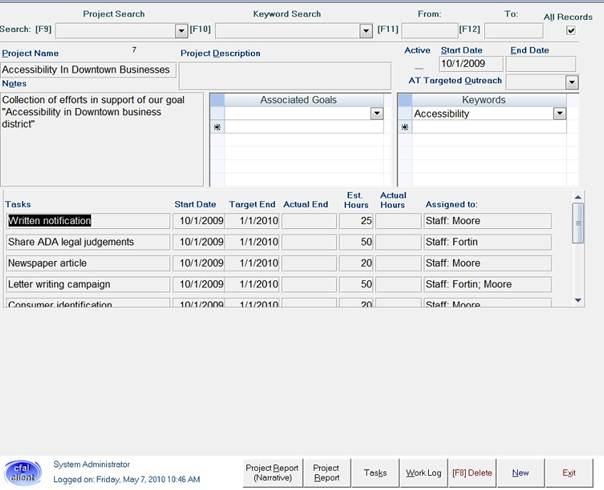
At the bottom of
the form there are additional buttons:

The Project
Report (Narrative) button will generate a Narrative Report
as a Word Document that will show the Project Name, Date, and Description,
with Work Log entries and Community Goals linked
to it.
The Project
Report button will generate a detailed report on a specific project
and all information pertaining to it.
Data Entry – Projects - Tasks
The Tasks button
will open a sub-form that allows you to associate tasks with a project.
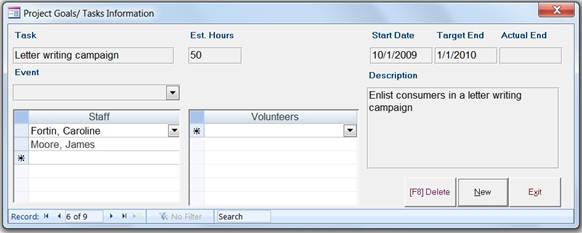
To enter a task,
press the New button, and
enter the Task, Estimated Hours, Start Date, Target
End and Actual End dates as appropriate. You can
select any number of your staff members to be associated with the task. Staff members must have
previously been entered as database users. You can also select any
number of volunteers to be associated with a task. Volunteers must be
designated via the People form.
Data Entry - Events
The Events form
allows you to enter events that can then be associated with Projects and Goals. As
with most forms, there is a section that allows you to search for an
event.
F9: To search by Event
name
F10: To search by Keyword
F11: To search for events with a
specific start date
F12: To search for events with a
specific end date
To enter a new
event, press the New button (or ALT +
N) and enter an Event Name, Time & Date, Event
Type and a Description as appropriate. By
clicking on Associated Goal or Associated Project a
list of previously entered goals and projects will be displayed. You can
associate the event with as many goals and projects as you wish. If you
wish to record a work log entry to be associated with the event, press
the Work Log button at the bottom of the screen.
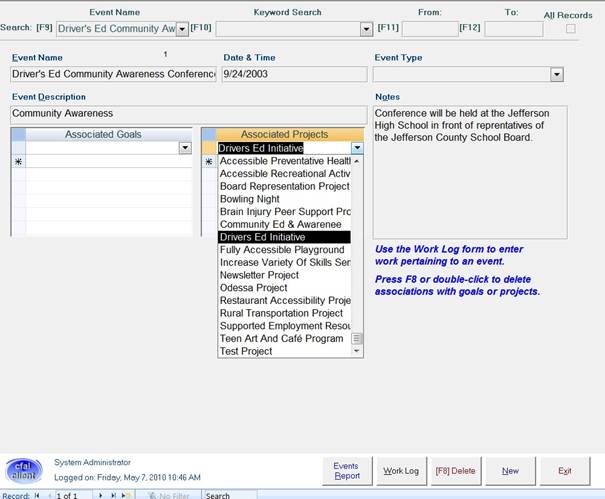
Data Entry - Outreach
Outreach represents
a special type of project or event. As such, a special form is provided
to record outreach activity. If the outreach activity involves recurring
events, consider the creation of a Project with the same name
as the activity. By doing so, you can allocate and segregate all of the
hours that you spend on the outreach activity and associate that time with one
of your organization’s goals. If the activity is not a recurring event,
it’s still a good idea to associate the effort expended with one of your
organization’s projects.
The following graphic show the outreach form.
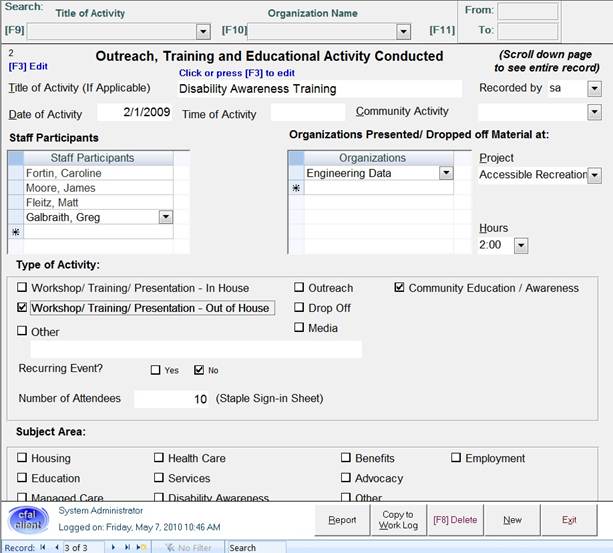
The Outreach form
can be used to collect information about Outreach, Training and Educational
Activity programs. Enter the Title of Activity, Date and Time as
appropriate. You can associate any Participating Staff member
and/or Organizations with the outreach event, and answer
specific questions related to the activity. The Outreach form also lets
you associate a Project and record the hours spent on a
specific activity. By pressing the Report button you can
generate a detailed report of the Outreach Activity. By pressing
the Copy to Work Log button, the Work Log form will open and
some of the information will be transferred automatically onto the form.
If several staff
members attend the same outreach activity only one staff person should complete
the Outreach form. The person who completes the form can
include all the names of the other people who attended the activity.
Data Entry – Inventory
Some
Independent Living Centers maintain an inventory of the adaptive equipment that
can be loaned to consumers. To create an inventory list click the Inventory button on the front screen of CFAL. To add a new item to the inventory list click
that New button at the bottom right-hand of the
screen.
Add a description of the inventory item in the Item box.
If your Independent Living Center uses some type of identification code for
each item you can enter that information in the Identification (Optional)
box. Enter the number of inventory items that you have in the Beginning
Inventory box. If the item is associated with a specific grant that
has been entered into the CFAL database you can associate that item with a
grant. You can also enter the date that you acquired each item in the Date Acquired box.
Once all your inventory items are entered into the database,
you can run a report to monitor how many of each item you have by clicking the Quantity On Hand button at
the lower left corner of the screen.
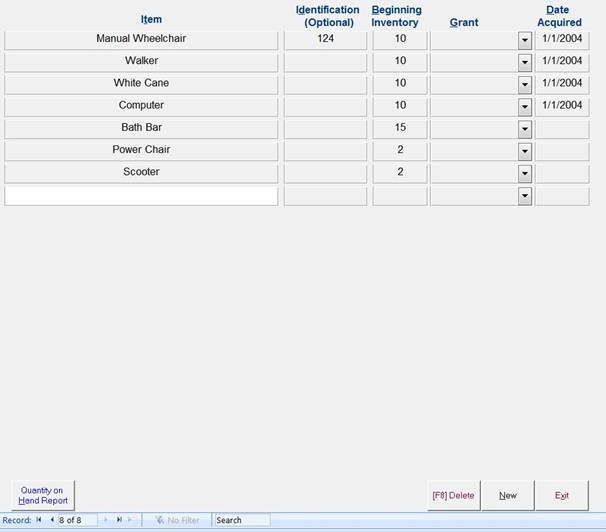
Letter Form
Correspondence – An Overview
CFAL Client can manage correspondence with people and
organizations whose address information is stored in its database. It takes
full advantage of the mail merge and object-linking features that are a part of
Microsoft Office. With CFAL Client and Office you can configure correspondence
in a variety of formats, target any group of people from within your database,
and track the flow of information to those groups. When entering personal
information into your database, select the preferred method of communication in
the “Letter Format” dropdown box near the bottom of the Personal Information
screen. The supported formats are audiotape, Braille, CD, letters in either standard or large print, and e-mail. The default is a
standard letter. If the contact does not wish to receive correspondence, select None from the dropdown list.
Any pre-configured letter can be sent from the Personal
Information (People) screen. To do so, press the Letter button near
the bottom of the screen, select the appropriate letter name from the pop-up
menu, and press “OK”. A copy of the letter will be queued for printing.
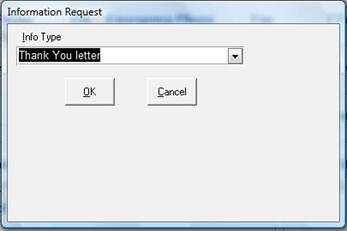
You can also generate an e-mail message to an individual from
within the People form. If you have entered a valid address in the
e-mail field, double-click the field, and if your workstation is properly
configured, an e-mail message will be generated for you to edit. If you
send the message, a record will be written to the individual’s history notes to
indicate the time that the message was sent. If you are unable to
generate an e-mail message, then your workstation mail system has not been
properly configured. Contact your system administrator for further
assistance.
Each
letter name can have two documents associated with it. One document is
designed to contain a standard-format version, and the other a large-text
version. A sample of each type is included with the CFAL application.
In most cases, your organization will choose to send e-mail or
pre-printed correspondence to its contacts. In such cases, you need only
to define a name for the correspondence in the Letters input form. You
can then generate an e-mail message, or create mailing labels to place on the
correspondence.
How to Send Letters
and Make Labels
In order to send a
new letter to a group of people, perform the following steps:
·
If you only wish to generate
e-mail or mailing labels, skip to step 2. Otherwise,
write your letter using any OLE-compliant word processing application, such as
WordPerfect or Microsoft Word. Create two versions – one with large text. You
may want to begin with a copy of the sample letters, as they are formatted with
the correct margins, hanging indents, and spacing to be compatible with the
application’s reports. It would probably be a good idea to store your finished
letters in a folder that is accessible to everyone who uses your network.
·
Open the Letters form from the Main form. The Letters button is located in the middle of
the main form, next to the Report button. A graphic of the form is
shown below:
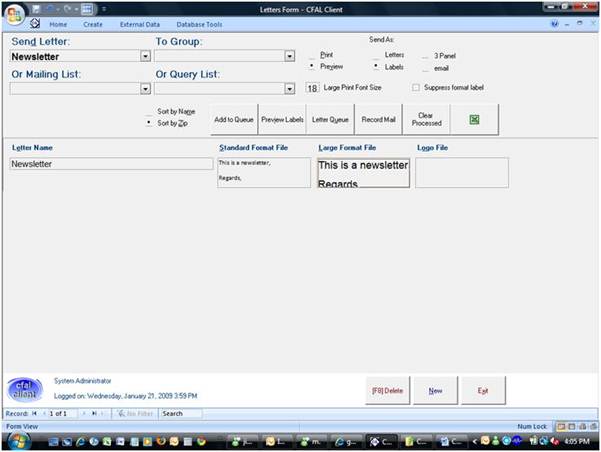
1-
Enter a descriptive name for the
letter in the Letter Name field.
2-
If you only wish to generate mailing labels or
send e-mail, skip to step 8. Otherwise, right-click
the Standard Format File field. Select Insert Object…from the pop-up
menu.
3-
Select Create
from File from the next
dialog box, as shown below.
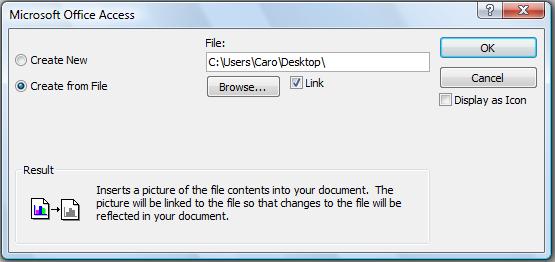
4-
Make sure that the Display as Icon check box is cleared, and that the Link check box is checked. Browse to the folder where you stored the
letters that you created, and select the appropriate document name.
5-
Repeat steps 4 through 6 in the
“Large Format File” field. If you want to print your letters on blank paper
using a custom logo file, repeat steps 4 through 6 in the “Logo File” field.
For best performance when including a custom logo, use a 100 dot-per-inch
GIF or bitmap image, 6.5 inches wide by one inch high. You must have an
OLE-compliant application on your computer that can edit your logo image type.
Examples of applications that can process GIF images are Corel Draw, Microsoft
Photo Editor, or Adobe Photoshop. MS Paint, an application that is supplied
with Microsoft Windows, can process bitmap images. Bitmaps therefore don’t
require special software for editing, but they are larger than GIFs, and they
don’t support transparent backgrounds. Sample logo images of each type,
formatted with the appropriate characteristics, are included with the
application.
6-
Once a letter has been configured as
described above, it can be edited by double-clicking on the appropriate field
in the Letters form. If you selected the Link option as described in step 6, any
changes that are made to letter documents will automatically update all
corresponding letters that are sent using the CFAL application.
7-
From the application Main screen,
select the name of the appropriate letter from the Send Letter dropdown box.
8-
If you want to send your letter to
all consumers, organizations, organization personnel, or to everyone in your
database, you can do so by making the appropriate selection in the To Group dropdown box. Note that organization
addresses can only be printed as mailing labels. If you need to send
alternate-format correspondence to a contact within an organization, list the
contact in the People form and specify the format that is
desired. By doing so you can also automatically track the date and time
when the correspondence was sent. If you want to send your letter to
every person and organization on a mailing list, select the appropriate
list. If you wish to target a specific group of individuals, you can
create a custom query that defines the group, and then select the query name
from the Or Query List dropdown box. A sample mass mail query
is included with the application. At a minimum, the query must include the
PersonID and CommFormatID fields from the People table. For more information on
custom query development, refer to Microsoft Access documentation.
9-
Press the Add to Queue button. All people in your database
who have been designated to receive a letter will be added to the letter queue.
If you wish, you can preview the letters and labels before printing by
selecting Preview from the Options menu near the top of
the Main form. When printing labels, the format (Standard, Large Print,
Braille…) will appear in the upper right-hand corner of each label unless you
select the Suppress Format option. If you wish to
include each person’s name and address on a letter that you have created,
select the Letters option near the bottom of the main
screen. Letters will print with each person’s name and address correctly positioned
for mailing in a standard number 10 window envelope. If you choose to print
labels, addresses are designed to print three-across on standard Avery number
5160 or 5260 label sheets. A third option allows you to print addresses onto
3-panel pre-folded mailers. When printed, all letters are sorted by zip code.
10-
After a batch of letters or labels
has been printed, you’ll be asked to confirm that all letters have printed
correctly. No prompt will be issued in the case of e-mail; it will be
assumed that the message was sent. If any letters need to be reprinted,
answer No to the prompt, preview the letters
again, and reprint as required. When each batch has processed correctly, answer Yes to the prompt, and all letters from
that batch will be marked as having been printed. It may be necessary to
iterate through the printing process several times before the letter queue will
record all mail as having been printed. At least one
iteration will be required for each type of correspondence and format
that is in the queue.
11-
When all correspondence has been
mailed, press the Record Mail or Clear
Processed buttons near the
bottom of the Main form. If you select Record
Mail, a transaction record
will be written for each person for whom a letter has been sent, indicating the
name of the letter and the time that the letter was sent. If a custom query was
used as the record source for the letter, the name of the query will be
recorded as well. If you select Clear
Processed, no transaction record will be stored. In either case, all
records in the letters queue that are marked with the print flag will be purged
from the queue.
12-
When printing letters as labels, the
requested letter format will be printed in the upper right corner of each label
unless you choose to suppress it. For alternate formats such as audiotape,
Braille, or diskette, labels will always be generated, and will list the
requested format. The labels can then be affixed to tapes, diskettes, or
envelopes as appropriate.
13-
If you encounter any problems while creating
mass mail, it’s easy to start over. Select the letter Queue button, and examine the status of all
correspondence that is waiting to be processed. You can easily clear the
print flag on all records by pressing F6 or selecting Clear Status. You can
also completely purge the queue and start over by pressing F8 or selecting Clear Queue.
Creating a Mass
E-Mail
To create a mass
e-mail, set the Letter Format to Standard on the People Form. Then, in the Letters form, you must select e-mail in the Send As option section. When you select Create e-mail, a message will
be automatically generated, and a string of e-mail addresses will be placed in
the BCC address
line. BCC means Blind
Carbon Copy; recipients of a BCC message will see only their own e-mail
address. Please note that only the records in the People table
containing a valid e-mail address will appear in your mass e-mail. For the
recipient’s convenience, two types of e-mail receipt can be configured:
standard and large print. By using this scheme, any attachments that you
wish to include with your correspondence can then be-preformatted according to
the recipient’s requirements.
Database Administration - Replication and synchronization
Replication – An Overview
The CFAL system is designed to support remote data
collection. Users who can connect laptop computers to your organization’s
office network can make a replica copy of your database,
disconnect from the network, collect data anywhere, and then transmit the
results back to your central database.
The
replication scheme that is implemented in CFAL uses internal business logic
that is specific to the application, not the standard
replication scheme that can be implemented in Microsoft Access. There are
advantages and disadvantages to this approach. The main advantage of an
application-specific replication scheme is that the replication logic maintains
better control of data exchange, since it has better knowledge of the
application’s requirements than a generic replication scheme can possess.
The database sizes are considerably smaller than they would be if generic
replication were used. The application’s internal logic also
automatically handles the resolution of write conflicts between database
copies, whereas a generic scheme cannot. The only disadvantage of the
specific replication scheme is that it does not allow for structural design
changes to the file server while there are unsynchronized replicas. This
disadvantage should not impose any problems in an operational environment, as
file server structure changes are rarely needed, and they can still be effected after data synchronization.
All
replication schemes must employ a method to handle write
conflicts. A conflict occurs when two or
more users using two or more copies of a database make edits to the same record
in more than one copy. When data is synchronized, one user’s changes must
be preserved while the others are discarded. CFAL uses the following
rules to resolve write conflicts between database copies:
·
Changes to configuration tables and
organizations are only preserved in the master (main) file server. For
example, disability and services lists will always be copied from the master to
the replica when synchronization is performed. Replica users should not
attempt to configure tables themselves, as their changes will be overwritten,
and doing so may result in the recording of erroneous data.
- Changes to personal information in the People table are assumed to be more current
in the replica than in the master. If a replica user makes changes
to a record that existed before the replica was created, those changes
will be made to the master record when synchronization is performed.
Any changes that were made to the same record in the master will be
overwritten. As such, care should be exercised if you have
outstanding replica copies of your database. Instead of editing
existing personal records in the master database, create new records, and
your edits will be preserved.
·
If two replicas make
edits to the same record in the People table, the changes in the replica that
performs the most recent synchronization will be preserved. You should be
careful to coordinate with your colleagues if you plan to use multiple
replicas. If two replica users must edit the files of the same person,
always create new records instead of editing existing records. Doing so
will ensure that all information is preserved.
There is nothing in the CFAL structure that prevents you from
implementing the standard Microsoft Access replication scheme if you wish, but
it is strongly advised that you not do so. If you implement Microsoft
replication and are not very careful, you may accidentally lose important data.
Make Replica
To make a replica database, perform the following steps:
1. Make
sure that your laptop or workstation is connected to your network, and that the
CFAL application is connected to your main file server. You can verify
the connection status by examining the “File Server” message in the lower
left corner of the Main screen.
2.
Press the Make
Replica button. ![]() A standard dialog box will appear.
A standard dialog box will appear.
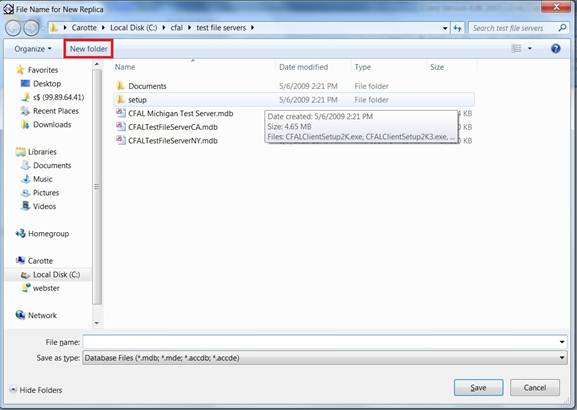
3.
Navigate to an folder on your laptop’s or
workstation’s local disk drive. It’s probably a good idea to keep your
CFAL data segregated in its own folder, but it isn’t necessary. To make a
new folder while the dialog box is open, press the New Folder icon in the upper part of the dialog
box, as shown in red in the picture above.
4.
Enter a filename and press Save. You
can use any name that you wish for your replica copy, but it’s best to pick a
name that will be easy to remember. It isn’t necessary to specify a file
extension (such as .mdb) with your filename. If you specify the name
of a file that already exists, you will be warned before the file is overwritten.
If the file is a replica that has just been synchronized with the master, there
is no harm in replacing it with a new copy.
5. An
exact copy of your master file server will be created. When the copy
operation is complete, you will be asked if you want to connect to the new
replica. If you answer yes, the application will connect
automatically. Once you are connected to the replica, you can
disconnect from your local area and work autonomously.
Synchronization
After you have collected a significant amount of data into your
replica file server, you can transmit the information to the master by
performing synchronization. To do so, utilize the following procedure:
1. Make
sure that your laptop or workstation is connected to your network,
and that the folder where your master file server resides is connected using
the same drive mapping as was done before you made the replica. If you
are at a remote location, you can make your connection
via dialup networking over a standard modem, or via Virtual
Private Networking (VPN) through an Internet connection.
2.
Press the Synchronize button.  A
confirmation message will appear that displays the approximate time required
for synchronization, based upon the size of your file servers and the speed of
your network connection. If you answer “Yes” to
the prompt, synchronization will be performed
automatically, and progress meters will be displayed in the status bar area of
the Main screen (lower left corner).
A
confirmation message will appear that displays the approximate time required
for synchronization, based upon the size of your file servers and the speed of
your network connection. If you answer “Yes” to
the prompt, synchronization will be performed
automatically, and progress meters will be displayed in the status bar area of
the Main screen (lower left corner).
3.
When the synchronization is complete, a report will be generated in preview
mode. If any errors occurred during the synchronization, they will be
detailed in the report.
4. If
you are connected to your network via a low-speed dialup connection, it’s
probably best to continue working with your replica database after
synchronization, as the creation of a new replica may take a long time.
If you have a high-speed connection, it’s best to make
a new replica after synchronization. In either case, keep in mind that
the longer you use a replica without creating a new one, the likelier that you
are to encounter errors when you synchronize.
For
additional assistance with any of the topics covered in this manual, licensed
users are encouraged to contact ed2c technical support:
(888)
678-0683
Return to Online Help Table of Contents
